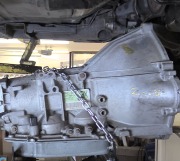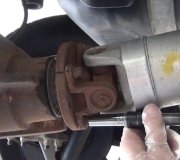Under the car, remove the starter and the cover to the torque converter. It will then open the area for you to access the bolts.
This is a very involved removal and replacement. You need a lift, an engine cradle, transmission jack, and something to hold the cradle while this process is happening.
Roy
Transmission Replacement
Tools Required
J 41623-B Cooler Quick Connect Tool
J 41160 Transmission Jack Adapter
Removal Procedure
1. Remove the upper filler panel.
ImageOpen In New TabZoom/Print
2. Remove the upper and lower air cleaner assemblies.
3. Disconnect the range selector cable terminal from the transaxle range selector lever.
4. Remove the nuts securing both the range selector cable bracket and heater pipe to the transaxle. Position the range selector cable bracket and heater pipe aside.
5. Remove the Magnasteer wire from the retaining clip.
6. Disconnect the master cylinder brake pipe retainers from the side rail.
Important: Supporting the brake pipes above the body side rail is necessary while removing the transaxle in order to prevent pinching of the brake pipes.
7. Remove the brake pipe retainers from the side rail and using mechanics wire, support the brake pipes above the side rail.
ImageOpen In New TabZoom/Print
8. Reposition the main wiring harness to gain access to the upper transaxle to engine bolts (1).
9. Remove the transaxle to engine bolts (1). The remaining bolt (2) will temporally retain the transaxle and will be removed from the underside of the vehicle.
10. Place a drain pan under the vehicle.
ImageOpen In New TabZoom/Print
11. Remove the upper transaxle oil cooler pipe retaining bolt from the radiator fan shroud.
12. Disconnect the upper transaxle oil cooler pipe from the radiator using the J 41623-B. Install plugs in the oil cooler pipe and the radiator to prevent fluid loss and contamination.
ImageOpen In New TabZoom/Print
13. Disconnect the lower transaxle oil cooler pipe from the transaxle and Install plugs in the oil cooler pipe and the transaxle to prevent fluid loss and contamination.
14. Disconnect the transaxle vent tube from the accelerator bracket.
15. Install the engine support fixture.
16. Raise and support the vehicle.
Caution: To avoid any vehicle damage, serious personal injury or death when major components are removed from the vehicle and the vehicle is supported by a hoist, support the vehicle with jack stands at the opposite end from which the components are being removed.
17. Secure the vehicle to the front hoist pads.
18. Remove the stabilizer shaft links.
19. Swing the stabilizer shaft downward in order to gain access to the power steering gear retaining bolts.
20. Remove the left front fascia extension.
Important: The following are exceptions while following the frame removal procedure:
Do not remove the front stabilizer shaft from the frame.
Do not remove the A.I.R. Pump assembly from the vehicle. Retain the pump to the body using mechanics wire.
Do not remove the insulators from the frame.
Do not remove the control arms from the frame.
21. Remove the front frame.
ImageOpen In New TabZoom/Print
22. Remove the bolt securing the left transaxle brace to the transaxle.
23. Loosen the nut securing the left transaxle brace to the engine.
24. Remove the left transaxle brace from the powertrain assembly.
ImageOpen In New TabZoom/Print
25. Remove the 3 ground connections from the side of the transaxle.
26. Disconnect the transaxle main electrical harness connector.
ImageOpen In New TabZoom/Print
27. Remove the bolt (2) securing the front transaxle brace (1) to the transaxle.
28. Remove the nut securing the secondary AIR pipe to the transaxle.
ImageOpen In New TabZoom/Print
29. Remove the nuts (2, 3) securing the vehicle speed sensor heat shield (1) to the transaxle.
30. Remove the vehicle speed sensor heat shield (1) from the vehicle.
31. Disconnect the vehicle speed sensor electrical connector.
ImageOpen In New TabZoom/Print
32. Remove only the bolts securing the front transaxle brace to the transaxle.
ImageOpen In New TabZoom/Print
33. Remove only the bolts securing the center transaxle brace to the transaxle.
ImageOpen In New TabZoom/Print
34. Disengage the right and left drive shafts (2) from the transaxle (1). The drive shafts do not have to be removed from the wheels.
35. Using mechanics wire, support the wheel drive shafts out of the way by tying them up to the strut spring.
ImageOpen In New TabZoom/Print
36. Remove the torque converter cover.
Important: Mark the flywheel to torque converter position so that they can be assembled in the same position.
37. Remove the flywheel to torque converter bolts.
38. Position the power steering gear pressure hose to the right side of the vehicle in order to clear the transaxle during removal.
39. Support the transaxle using the J 41160 and a suitable transmission jack.
40. Secure the J 41160 to the transaxle.
ImageOpen In New TabZoom/Print
41. Remove the nut (1) securing the left transaxle mount to the left transaxle mount bracket.
ImageOpen In New TabZoom/Print
42. Remove the remaining transaxle to engine bolt (2).
43. Separate the transaxle from the engine.
44. Tilt the transaxle using the support jack enough to allow clearance for the starter nose cone.
Important: Ensure clearance is maintained between the transaxle and the following:
The brake pipes
The secondary AIR pipe
The power steering pressure hose
The wiring harnesses
45. Carefully lower the transaxle from the vehicle.
46. Complete the following if transaxle replacement is necessary:
Remove the transaxle cooler pipe.
Remove the left transaxle bracket.
Remove the rear transaxle bracket.
Monday, October 8th, 2018 AT 12:51 PM



